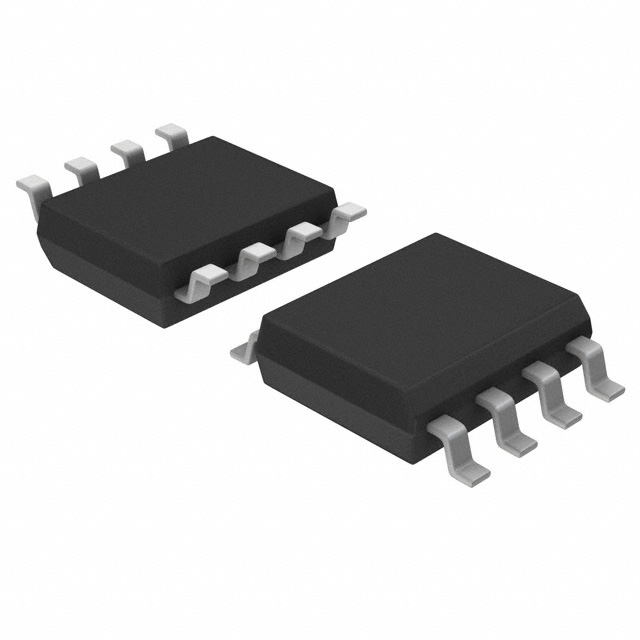Szczegóły produktu można znaleźć w specyfikacjach.

TPS2377DR-1
Product Overview
Category
The TPS2377DR-1 belongs to the category of integrated circuits (ICs) specifically designed for power over Ethernet (PoE) applications.
Use
This IC is primarily used in PoE systems to provide power and data transmission over a single Ethernet cable. It enables the delivery of electrical power to devices such as IP cameras, wireless access points, and VoIP phones, eliminating the need for separate power cables.
Characteristics
- Power over Ethernet (PoE) functionality
- Integrated power management features
- High efficiency and reliability
- Compact package size
- Easy integration into existing PoE systems
Package
The TPS2377DR-1 is available in a small outline integrated circuit (SOIC) package. This package offers excellent thermal performance and ease of handling during assembly.
Essence
The essence of the TPS2377DR-1 lies in its ability to efficiently deliver power and data over Ethernet cables, simplifying the installation and operation of PoE-enabled devices.
Packaging/Quantity
The TPS2377DR-1 is typically packaged in reels or tubes, with each reel or tube containing a specific quantity of ICs. The exact packaging and quantity may vary depending on the supplier.
Specifications
- Input Voltage Range: 36V to 57V
- Output Voltage Range: 3.3V to 5V
- Maximum Output Current: 600mA
- Operating Temperature Range: -40°C to 85°C
- Power Dissipation: 1.2W
- Efficiency: Up to 90%
- Protection Features: Overcurrent, Overvoltage, and Thermal Shutdown
Detailed Pin Configuration
The TPS2377DR-1 has a total of 8 pins, each serving a specific function:
- VDD: Power supply input pin
- GND: Ground reference pin
- VSS: Negative power supply input pin
- VOUT: Output voltage pin
- EN: Enable pin for controlling the IC's operation
- FB: Feedback pin for voltage regulation
- ILIM: Current limit setting pin
- VIN: Input voltage pin
Functional Features
- Integrated DC-DC converter for efficient power delivery
- Automatic detection and classification of PoE devices
- Adjustable current limit for device protection
- Overvoltage and thermal shutdown protection mechanisms
- Low-power standby mode for energy conservation
Advantages and Disadvantages
Advantages
- Simplifies installation by eliminating the need for separate power cables
- Enables remote powering of devices in hard-to-reach locations
- Reduces overall system cost and complexity
- Provides reliable and efficient power delivery
- Offers protection features for enhanced device safety
Disadvantages
- Limited maximum output current may not be suitable for high-power devices
- Requires compatible PoE-enabled devices for proper functionality
- May require additional circuitry for certain applications
Working Principles
The TPS2377DR-1 operates based on the principles of power over Ethernet. It utilizes a DC-DC converter to convert the input voltage from the Ethernet cable into a regulated output voltage suitable for powering connected devices. The IC also incorporates various protection mechanisms to ensure safe and reliable operation.
Detailed Application Field Plans
The TPS2377DR-1 finds extensive application in various fields, including:
- IP Surveillance Systems: Enables the deployment of IP cameras without the need for separate power cables, simplifying installation and reducing costs.
- Wireless Access Points: Powers wireless access points in locations where electrical outlets are not readily available, such as outdoor environments.
- Voice over IP (VoIP) Phones: Provides power to VoIP phones, eliminating the need for external power adapters and streamlining deployment.
Detailed and Complete Alternative Models
- TPS2377DR: Similar to TPS2377DR-1 but with a different pin configuration.
- TPS2377DGK: Available in a different package (MSOP) with similar functionality.
- TPS2377PW: Offers higher maximum output current (up to 1A) for powering more demanding devices.
Please note that the above alternative models are just a few examples, and there may be other alternatives available in the market.
Word count: 606 words
Wymień 10 typowych pytań i odpowiedzi związanych z zastosowaniem TPS2377DR-1 w rozwiązaniach technicznych
Sure! Here are 10 common questions and answers related to the application of TPS2377DR-1 in technical solutions:
Q1: What is TPS2377DR-1? A1: TPS2377DR-1 is a Power over Ethernet (PoE) powered device controller that integrates both the IEEE 802.3bt-compliant PoE PD interface and a DC/DC converter.
Q2: What is the maximum power output of TPS2377DR-1? A2: TPS2377DR-1 can deliver up to 90W of power to the connected device.
Q3: Can TPS2377DR-1 be used with both Type 3 and Type 4 PoE systems? A3: Yes, TPS2377DR-1 is compatible with both Type 3 and Type 4 PoE systems.
Q4: Does TPS2377DR-1 support power classification? A4: Yes, TPS2377DR-1 supports power classification according to the IEEE 802.3bt standard.
Q5: What is the input voltage range for TPS2377DR-1? A5: TPS2377DR-1 operates with an input voltage range of 36V to 57V.
Q6: Can TPS2377DR-1 provide power to multiple devices simultaneously? A6: Yes, TPS2377DR-1 can provide power to multiple devices through its multiple output channels.
Q7: Is TPS2377DR-1 suitable for outdoor applications? A7: Yes, TPS2377DR-1 is designed to operate reliably in outdoor environments.
Q8: Does TPS2377DR-1 have built-in protection features? A8: Yes, TPS2377DR-1 includes various protection features such as overcurrent protection, overvoltage protection, and thermal shutdown.
Q9: Can TPS2377DR-1 be used in industrial automation systems? A9: Yes, TPS2377DR-1 is suitable for use in industrial automation systems due to its robust design and wide operating temperature range.
Q10: What are the typical applications of TPS2377DR-1? A10: TPS2377DR-1 can be used in a variety of applications including IP cameras, wireless access points, VoIP phones, and other PoE-powered devices.
Please note that these answers are general and may vary depending on specific implementation requirements.

